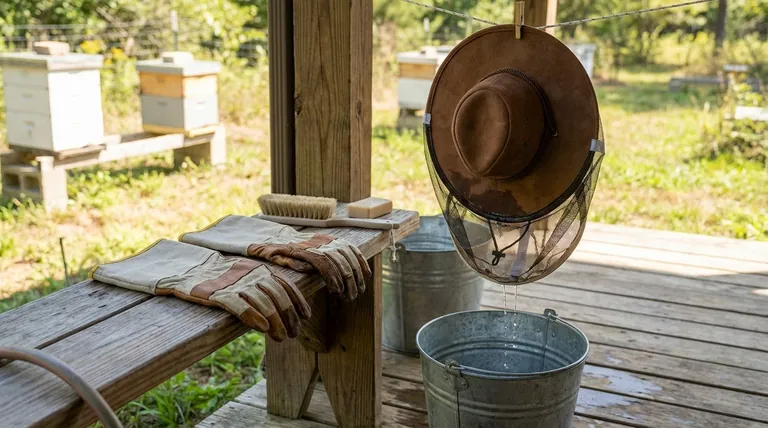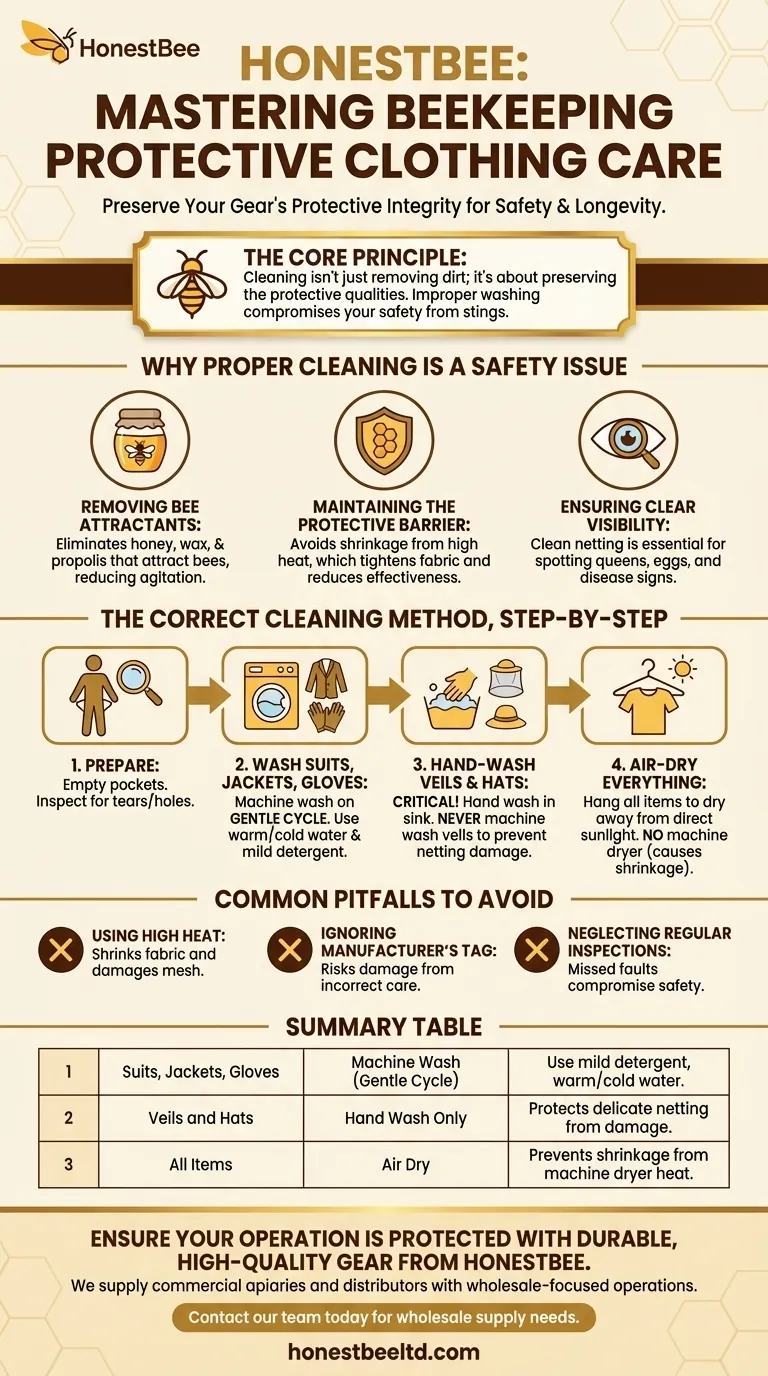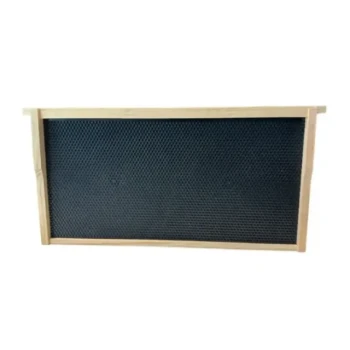To properly clean beekeeping protective clothing, you must differentiate between its components. Most bee suits, jackets, and gloves can be machine washed on a gentle cycle, but the veil and hat assembly must always be hand-washed to prevent damage to the fine netting. Critically, all items should be hung to air dry, as the high heat of a machine dryer can cause shrinkage and compromise the suit's protective integrity.
The core principle of cleaning beekeeping gear isn't just about removing dirt; it's about preserving the protective qualities of the equipment. Improper washing can damage the very features designed to keep you safe from stings.

Why Proper Cleaning is a Safety Issue
Your protective clothing is your most important piece of beekeeping equipment. Keeping it clean is a matter of maintenance that directly impacts your safety and effectiveness when working with your colonies.
Removing Bee Attractants
Your suit will inevitably gather honey, wax, and propolis. Spilled honey can attract bees from your own or neighboring hives, leading to unwanted attention and potential agitation.
Maintaining the Protective Barrier
The fabric of a bee suit is designed to create a thick barrier that bee stingers cannot easily penetrate. High-heat washing or machine drying can shrink the material, making it tighter against your body and reducing its effectiveness.
Ensuring Clear Visibility
A dirty veil is a liability. Smudges of propolis, honey, or dirt on the netting can obscure your vision, making it difficult to spot your queen, identify eggs, or notice signs of disease. Clean netting is essential for detailed hive inspections.
The Correct Cleaning Method, Step-by-Step
Follow a specific process for each piece of your gear. Before you begin, always check for and follow the manufacturer’s specific care instructions.
Step 1: Prepare the Clothing
Before washing, empty all pockets. It's also a good time to do a quick visual inspection for any tears or holes around seams and closures that may need repair.
Step 2: Wash Suits, Jackets, and Gloves
Most modern bee suits and gloves made of cotton or polyester blends are machine-washable. Use a gentle cycle with warm or cold water and a mild detergent. Washing them together is typically fine.
Step 3: Hand-Wash Veils and Hats
This is the most critical step. Never put a veil in a washing machine. The agitation can easily tear the delicate netting or damage the hat's structure. Instead, hand wash the veil and hat assembly in a sink with warm, soapy water and rinse thoroughly.
Step 4: Air-Dry Everything
Hang all components to dry, preferably out of direct sunlight to prevent material degradation. A machine dryer's heat will cause shrinkage, which can make a suit uncomfortably tight and less protective.
Common Pitfalls to Avoid
Mistakes in the cleaning process can shorten the lifespan of your gear and reduce its effectiveness.
Ignoring the Manufacturer's Tag
Your suit's care tag is the ultimate authority. Different materials and blends may have unique requirements. Ignoring these instructions is the fastest way to damage your investment.
Using High Heat
Heat is the primary enemy of beekeeping clothing. It shrinks fabric and can warp or damage the plastic mesh of a veil. Always opt for cold or warm water and never use a machine dryer.
Neglecting Regular Inspections
Washing your gear provides the perfect opportunity for maintenance. After it's clean and dry, carefully inspect all zippers and Velcro closures to ensure they function correctly. Check every seam for small holes or tears that a bee could exploit.
Making the Right Choice for Your Gear
Your maintenance routine should align with your priorities as a beekeeper.
- If your primary focus is safety: Make a post-wash inspection for holes, tears, and faulty zippers a mandatory part of your routine.
- If your primary focus is equipment lifespan: Commit to always using gentle wash cycles and air-drying every piece of gear to prevent material stress and shrinkage.
- If your primary focus is hive health: Ensure your veil is spotless before every inspection to guarantee you can clearly see eggs, larvae, and signs of disease.
Properly maintaining your protective clothing is a direct investment in your confidence and safety in the apiary.
Summary Table:
| Step | Component | Cleaning Method | Key Consideration |
|---|---|---|---|
| 1 | Suits, Jackets, Gloves | Machine Wash (Gentle Cycle) | Use mild detergent, warm/cold water. |
| 2 | Veils and Hats | Hand Wash Only | Protects delicate netting from damage. |
| 3 | All Items | Air Dry | Prevents shrinkage from machine dryer heat. |
Ensure your beekeeping operation is always protected with durable, high-quality gear from HONESTBEE. We supply commercial apiaries and beekeeping equipment distributors with wholesale-focused operations. Our protective clothing is designed for longevity and safety when maintained correctly. Contact our team today to discuss your wholesale supply needs and invest in gear that protects both you and your business.
Visual Guide

Related Products
- Heavy Duty Cowboy Beekeeper Hat with Visibility Veil Outdoor Professional Beekeeping Protective Gear
- Square Folding Bee Hat Veil with String for Beekeeping
- Beekeeper Cowboy Hat and Veil for Beekeeping
- Yellow Plastic Bucket Pail Perch for Beekeeping
- Long Langstroth Style Horizontal Top Bar Hive for Wholesale
People Also Ask
- Why are a hat and veil considered the most important parts of beekeeping protective gear? Essential Protection for Your Face and Confidence
- What activities is the beekeeping hat suitable for? Beyond the Hive for Ultimate Outdoor Protection
- How does the design of the beekeeping hat ensure comfort during extended use? Maximize Comfort for Long Apiary Hours
- What features enhance the quality of the beekeeping veil? Choose the Right Protection for Your Apiary
- What is the purpose of a hat and veil in beekeeping? Essential Protection for Head & Face



















